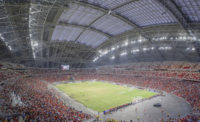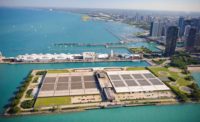The aquarium business "is dependent on the engineering challenges of containing water and resisting corrosion of materials; longevity; and low maintenance,” says Peter Chermayeff, an architect who has been designing major aquariums around the world for over 50 years.
Aquariums—for which ENR has compiled a list at left of the world's largest—are typically built by general contractors with experience in the water and wastewater sectors. One example is Brasfield & Gorrie. The contractor's first fish habitat was Atlanta's Georgia Aquarium, which contains the world’s largest single fish tank, the Ocean Voyager tank. The container is like "a giant treatment plant, with 100% turnover of water every 60 to 90 minutes,” says Chris Britton, division manager for Brasfield & Gorrie.
The aquarium opened in 2005. Brasfield & Gorrie was later hired to carry out a 1.8-million-gallon expansion of the dolphin habitat, which was finished in 2010.
Constructing the massive acrylic panel for the tank’s window was a challenge. The 24-in.-thick panel contained six pieces of acrylic annealed together on site. It weighed 120 tons, says Britton. Workers from Nippura Co. Ltd., which supplied the panel, “built scaffolding around the panel sections, and hung heat tents, allowing the sections to cool down over time to form the chemical bond.”
Japan's Nippura, based in Sanuki, Kagawa, has only one competitor that also designs, manufactures, fabricates and installs large acrylic windows for institutional aquariums. It is Reynolds Polymer Technology, Grand Junction, Colo. “A lot of aquariums are being built in malls and private parks—they are entrepreneurially driven," says Scott Sullivan, Reynolds' president. "Asia is a fertile market; over 50% of our sales are overseas.”
The aquarium sector has advanced tremendously on other technology fronts over the last several decades. “Water quality is very important—you have to guarantee enough oxygen," says Jurgen Lange, former chief operating officer of the Berlin Zoo-Aquarium. “An aquarium is a closed system—uneaten food and animal droppings are dissolved. We now employ ultraviolet light to sterilize and protein skimmers, which make a foam in the water, to help remove proteins.”
Of aquariums currently under development, Acquario Ceará in Fortaleza, Brazil, is most unusual in appearance. It’s biomorphic exoskeleton echoes a crustacean’s shape. Leonardo Fontenele, CEO and president of Imagic Brasil, the São Paulo branch of Jack Rouse Associates, in Cincinnati, designed the project. The design-build firm International Concept Management, Grand Junction, Colo., is constructing the 231,000-sq-ft facility.
Peru is planning a new national aquarium in Lima. The conceptual design by Studio Hanson l Roberts, based on Bainbridge Island, Wash., will concentrate exclusively on Peruvian species, housing only those species that can easily adapt to aquarium care, and educating local fishermen to acquire sustainably sourced specimens.
Looking back over his career, Chermayeff outlines some of the ways in which aquarium design has evolved. “Our first aquarium [in Boston, in 1969] had quite a strong architectural form outside and inside. The National Aquarium [in Baltimore, in 1981] had a lot of concrete structure, enclosing volumes of water, and a more playful interior, more explosive than Boston. Visitors are given the experience of being underwater.”
For his third project, in Chattanooga in 1992, Chermayeff paid “more attention to habitat—more replication of natural settings. On our fourth project, in Osaka, in 1990, we made a kind of labyrinth—the public would walk between walls of water held by a structural form … visitors have the feeling of getting lost in the sea, while following a path. Now the architecture was disappearing and the ocean was taking over," he says.














Post a comment to this article
Report Abusive Comment